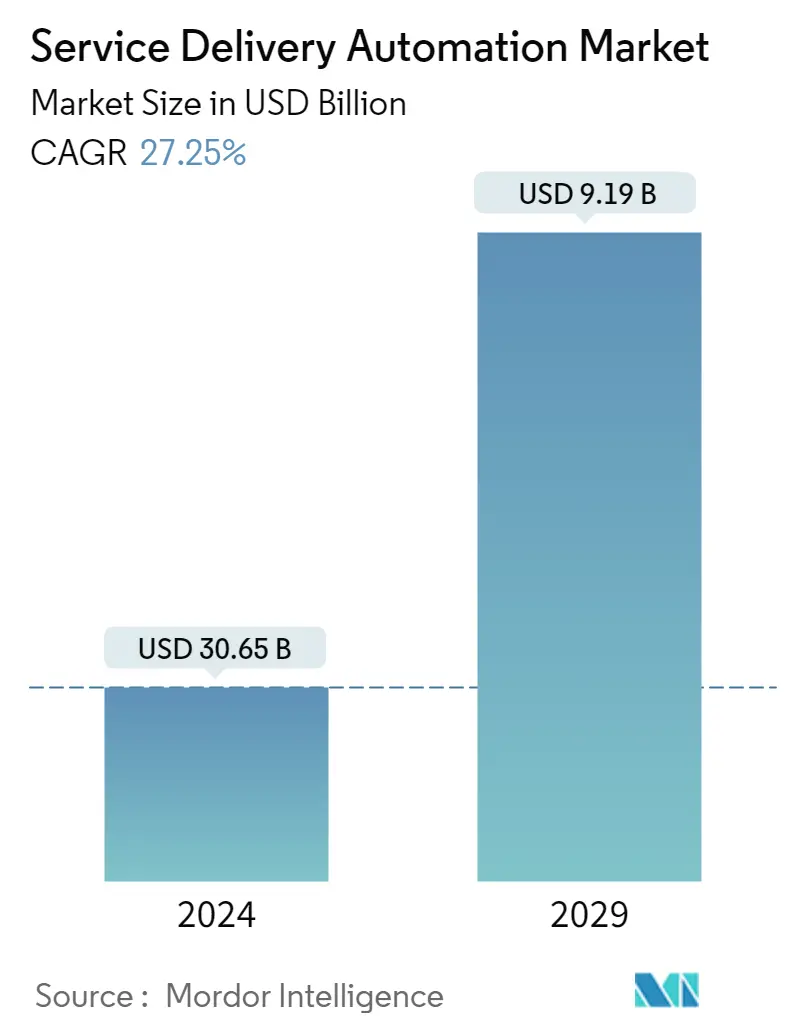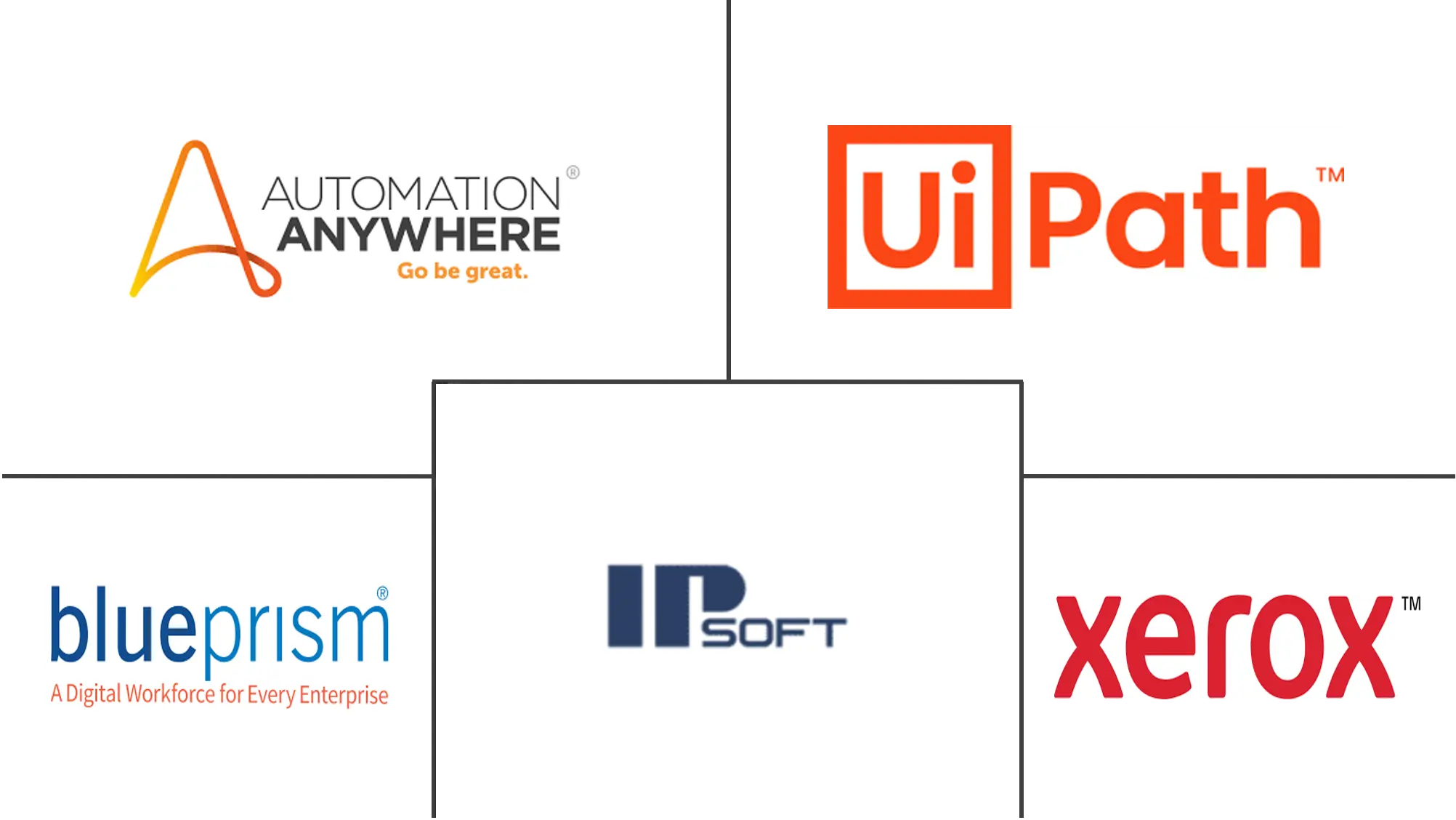Market Size of Service Delivery Automation Industry

| Study Period | 2019 - 2029 |
| Market Size (2024) | USD 30.65 Billion |
| Market Size (2029) | USD 9.19 Billion |
| CAGR (2024 - 2029) | 27.25 % |
| Fastest Growing Market | Asia Pacific |
| Largest Market | North America |
| Market Concentration | Low |
Major Players
*Disclaimer: Major Players sorted in no particular order |
Service Delivery Automation Market Analysis
The Service Delivery Automation Market size is estimated at USD 30.65 billion in 2024, and is expected to reach USD 9.19 billion by 2029, growing at a CAGR of 27.25% during the forecast period (2024-2029).
Automation enables digitally equipped enterprises or businesses to transform their service delivery and operations, bringing cost savings, accuracy, and increased productivity. It generates valuable data, facilitating smarter and faster decision-making by optimizing current processes and operations and predicting when, where, and how to provide new products and services.
- The market for service delivery automation is expanding due to the growing adoption of a digital workforce and the functional advantages of automation solutions for business process automation across various end-user sectors.
- Market vendors enhance their offerings by adding new features such as automation lifecycle management, workload management, credential management, SLA-based automation, Citrix automation, and new data APIs, attracting new industries looking for higher operational and security capabilities.
- Smart process automation, big data, IoT, integration with other tools, and an increase in the adoption of service automation tools are the primary factors driving automation's growth. Furthermore, automation can create many jobs, driving demand for skilled workforces in different industries.
- However, the need for more skilled professionals to develop and manage automation processes might hinder this market's growth as new technologies get introduced exponentially. There is a need to re-skill the aging workforce to keep pace with automation's evolution.
- The COVID-19 pandemic positively impacted the market as online retail sales increased. Furthermore, using artificial intelligence (AI) and machine learning (ML), innovation leaders and business pioneers can develop the best frameworks for everything from staffing to finance and development to production.
Service Delivery Automation Industry Segmentation
Service delivery automation (SDA) is defined as an umbrella concept for the new technologies that automate a series of human actions in an IT or business process. SDA has the ability to match legacy technologies with automated technologies that can simplify different business cases and minimize disruption. The industries like retail, hospitality, healthcare, and logistics are embracing automation.
The service delivery automation market is segmented by type (IT process automation and business process automation), organization size (large enterprises and small and medium enterprises (SMEs)), end-user vertical (BFSI, IT, telecommunication, and media, hospitality, and transportation, retail and consumer goods, healthcare and pharmaceuticals, manufacturing, and logistics), and geography (North America, Europe, Asia Pacific, Latin America, Middle East & Africa).The market sizes and forecasts are provided in terms of value (USD) for all the above segments.
| By Type | |
| IT Process Automation | |
| Business Process Automation |
| By Organization Size | |
| Large Enterprises | |
| Small & Medium Enterprises (SMEs) |
| By End-user Industry | |
| BFSI | |
| IT | |
| Telecommunication and Media | |
| Hospitality and Transportation | |
| Retail and Consumer Goods | |
| Healthcare and Pharmaceuticals | |
| Manufacturing and Logistics | |
| Other End-User Industries |
| By Geography | |
| North America | |
| Europe | |
| Asia Pacific | |
| Latin America | |
| Middle East and Africa |
Service Delivery Automation Market Size Summary
The service delivery automation market is experiencing significant growth, driven by the increasing adoption of digital workforces and the functional benefits of automation solutions across various sectors. Automation is transforming service delivery and operations, offering cost savings, enhanced accuracy, and improved productivity. The market is characterized by the integration of smart process automation, big data, and IoT, which are key factors propelling its expansion. The COVID-19 pandemic has further accelerated this growth, particularly in the retail and e-commerce sectors, where demand for faster order processing and delivery has surged. The use of autonomous mobile robots in warehouses exemplifies the shift towards automation, as these technologies streamline operations and reduce reliance on manual labor.
In the Asia-Pacific region, the market is expanding robustly due to the widespread adoption of automation by large and medium-sized enterprises. The transition to Industry 4.0 and the increasing need for automation in sectors like BFSI, telecom, and healthcare are driving this growth. The market is fragmented, with major players such as Blue Prism, Nice Systems, and IBM competing for dominance. These companies are enhancing their offerings through strategic partnerships and technological advancements, such as UiPath's platform upgrades and Blue Prism's collaboration with SS&C. These developments underscore the industry's focus on innovation and efficiency, as companies strive to meet the growing demand for automation services to reduce costs and improve customer satisfaction.
Service Delivery Automation Market Size - Table of Contents
-
1. MARKET INSIGHTS
-
1.1 Market Overview
-
1.2 Industry Attractiveness - Porter's Five Forces Analysis
-
1.2.1 Bargaining Power of Suppliers
-
1.2.2 Bargaining Power of Consumers
-
1.2.3 Threat of New Entrants
-
1.2.4 Intensity of Competitive Rivalry
-
1.2.5 Threat of Substitutes
-
-
1.3 Impact of COVID-19 on the Market
-
-
2. MARKET SEGMENTATION
-
2.1 By Type
-
2.1.1 IT Process Automation
-
2.1.2 Business Process Automation
-
-
2.2 By Organization Size
-
2.2.1 Large Enterprises
-
2.2.2 Small & Medium Enterprises (SMEs)
-
-
2.3 By End-user Industry
-
2.3.1 BFSI
-
2.3.2 IT
-
2.3.3 Telecommunication and Media
-
2.3.4 Hospitality and Transportation
-
2.3.5 Retail and Consumer Goods
-
2.3.6 Healthcare and Pharmaceuticals
-
2.3.7 Manufacturing and Logistics
-
2.3.8 Other End-User Industries
-
-
2.4 By Geography
-
2.4.1 North America
-
2.4.2 Europe
-
2.4.3 Asia Pacific
-
2.4.4 Latin America
-
2.4.5 Middle East and Africa
-
-
Service Delivery Automation Market Size FAQs
How big is the Service Delivery Automation Market?
The Service Delivery Automation Market size is expected to reach USD 30.65 billion in 2024 and grow at a CAGR of 27.25% to reach USD 9.19 billion by 2029.
What is the current Service Delivery Automation Market size?
In 2024, the Service Delivery Automation Market size is expected to reach USD 30.65 billion.

